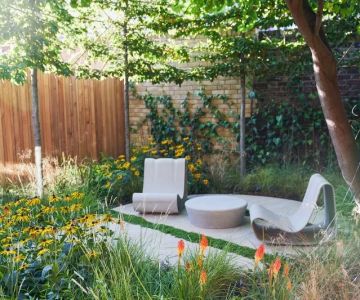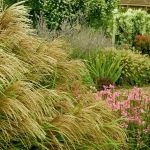
- 1. What Is a Sensory Garden?
- 2. The Importance of Sensory Gardens
- 3. Designing for Smell in a Sensory Garden
- 4. Designing for Touch in a Sensory Garden
- 5. Designing for Sound in a Sensory Garden
- 6. Choosing Plants for a Sensory Garden
- 7. Enhancing the Sensory Experience: Tips and Ideas
- 8. Where to Find Sensory Garden Plants and Supplies
1. What Is a Sensory Garden?
A sensory garden is a specially designed space that stimulates the senses through the use of plants, textures, sounds, and scents. These gardens are intended to engage the senses of smell, touch, sight, and sound, and can be therapeutic or relaxing spaces for people of all ages. Sensory gardens are particularly beneficial for individuals with disabilities, those undergoing rehabilitation, or anyone seeking a calming outdoor experience.
Unlike traditional gardens that may focus primarily on aesthetics, sensory gardens are intentionally designed to provide a multi-sensory experience. Whether you're designing your garden for personal enjoyment or as a therapeutic space, creating a sensory garden can bring added depth and enjoyment to your outdoor environment.

Alvarado's Landscape & Maintenance
28W600 Roosevelt Rd, Winfield, IL 60190, USA
2. The Importance of Sensory Gardens
Sensory gardens have become increasingly popular for several reasons. These gardens provide therapeutic benefits, improve mental and emotional well-being, and offer a space for relaxation and mindfulness. Engaging with nature through the senses can help reduce stress, enhance relaxation, and improve focus and concentration. For children and adults with autism, sensory gardens can be particularly effective in providing a safe and stimulating environment to explore sensory input.
Sensory gardens are also great for those who enjoy gardening but may have physical limitations. The garden can be tailored to include plants and features that are accessible, such as raised beds or fragrant plants that require less maintenance. Additionally, sensory gardens often require fewer plants that thrive in diverse conditions, making them easier to maintain over time.

Elite Landscape Management Inc
15450 W 159th St, Homer Glen, IL 60491, USA
3. Designing for Smell in a Sensory Garden
Smell is one of the most powerful senses when it comes to creating a sensory experience. When designing a sensory garden, incorporating plants with aromatic flowers, herbs, and foliage can create a fragrant environment that changes with the seasons. Smell engages both memory and emotion, making it an important element of sensory garden design.
1. Fragrant Plants for Smell
Some of the best plants for creating a fragrant garden include:
- Lavender – Known for its calming properties, lavender provides a lovely scent, especially during warmer months.
- Roses – Classic and fragrant, many varieties of roses are perfect for sensory gardens.
- Mint and Basil – Both herbs offer an uplifting scent and can be used in cooking as well.
- Jasmine – A sweet, strong fragrance that can fill the air during summer evenings.
By placing fragrant plants in strategic locations within the garden—near pathways, seating areas, or close to the entrance—you can ensure that the smell hits you the moment you walk into the garden. Different plants bloom at different times of the year, so you can plan for a rotating fragrance experience all year long.
4. Designing for Touch in a Sensory Garden
Touch is a sensory experience that often goes overlooked, but it can add significant depth to a garden. The textures of leaves, flowers, and other natural materials can create a tactile experience that encourages visitors to interact physically with the space. Whether it’s the soft petals of a flower or the rough texture of tree bark, touch is an essential element of sensory gardens.
1. Plants with Interesting Textures
To create an engaging tactile experience, choose plants with diverse textures, such as:
- Soft Lamb’s Ear – Known for its fuzzy, velvety leaves, this plant invites touch.
- Succulents – Their plump, thick leaves provide a smooth yet firm feel.
- Hostas – With large, broad leaves, hostas offer a soft touch perfect for tactile exploration.
- Thyme and Sage – Both of these herbs have fragrant and textured leaves, adding a different tactile element to the garden.
Incorporating elements like stone paths, smooth pebbles, and different soil textures will also enhance the tactile experience. Placing tactile elements around seating areas or along garden pathways invites visitors to engage with their surroundings more deeply.
5. Designing for Sound in a Sensory Garden
Sound is another important sensory experience that can be incorporated into your garden design. The sounds of nature, whether it's the rustling of leaves, birds singing, or water flowing, can greatly enhance the ambiance of a sensory garden. Adding elements that create soothing sounds or draw attention to natural sounds is a great way to deepen the sensory experience.
1. Water Features
One of the best ways to introduce sound into your garden is with a water feature. Fountains, streams, and ponds can all add gentle, calming sounds of water trickling or splashing. The soothing sound of water has been shown to reduce stress and enhance relaxation, making it an ideal feature in any sensory garden.
2. Wind Chimes and Bells
Wind chimes, bells, or even bamboo wind instruments can create a gentle, melodic sound as the breeze moves through them. Placing them strategically near seating areas or walkways ensures that visitors are surrounded by pleasant sounds that add to the sensory experience.
6. Choosing Plants for a Sensory Garden
When selecting plants for your sensory garden, consider plants that engage more than one of the senses. For example, plants like lavender can appeal to both the sense of smell and touch, while the bright colors of flowers can provide visual stimulation. Choose plants that are native to your area to ensure they thrive in the local climate, and consider adding both seasonal and perennial plants for year-round interest.
1. Multi-Sensory Plants
Some plants are great for engaging multiple senses. These include:
- Rosemary – A fragrant herb with aromatic foliage and small blue flowers, great for smell and touch.
- Sunflowers – Their towering height, vibrant yellow petals, and seeds are visually stimulating and attract birds and insects, creating natural sounds.
- Ferns – Their soft fronds provide a gentle touch, and their cool, shady presence creates a calming atmosphere.
7. Enhancing the Sensory Experience: Tips and Ideas
To fully enhance the sensory experience in your garden, incorporate elements like seating areas, shaded nooks, and walkways that encourage exploration. Consider adding aromatic candles, essential oil diffusers, or outdoor lighting that changes the ambiance at night. You can also introduce decorative elements such as sculptures or colorful containers that add to the visual appeal while engaging the other senses.
8. Where to Find Sensory Garden Plants and Supplies
If you're looking to design your sensory garden and need plants or supplies, Beautiful Landscapes offers a variety of plants and garden tools perfect for creating your ideal sensory garden. Whether you’re looking for fragrant flowers, textural foliage, or water features, Beautiful Landscapes has everything you need to bring your sensory garden vision to life.







 Nolands Landscaping Inc5.0 (3 reviews)
Nolands Landscaping Inc5.0 (3 reviews) Pure Valley Landscaping Inc0.0 (0 reviews)
Pure Valley Landscaping Inc0.0 (0 reviews) Schertz Services, LLC4.0 (7 reviews)
Schertz Services, LLC4.0 (7 reviews) Mayco’s Landscaping5.0 (8 reviews)
Mayco’s Landscaping5.0 (8 reviews) Walmart Patio & Garden Services0.0 (0 reviews)
Walmart Patio & Garden Services0.0 (0 reviews) RJK Barone Lawn & Landscaping4.0 (19 reviews)
RJK Barone Lawn & Landscaping4.0 (19 reviews) How to Choose the Right Mulch for Weed Suppression: A Complete Guide
How to Choose the Right Mulch for Weed Suppression: A Complete Guide How to Design for Natural Drainage Without Artificial Systems
How to Design for Natural Drainage Without Artificial Systems How to Use Native Grasses for Texture & Movement in Your Garden
How to Use Native Grasses for Texture & Movement in Your Garden How to Choose Plants That Don’t Compete: A Guide for Perfect Landscaping
How to Choose Plants That Don’t Compete: A Guide for Perfect Landscaping How to Design With Movement: Plants That Sway Gracefully in Your Garden
How to Design With Movement: Plants That Sway Gracefully in Your Garden How to Convert a Concrete Patio Into a Green Oasis | Beautiful Landscapes
How to Convert a Concrete Patio Into a Green Oasis | Beautiful Landscapes